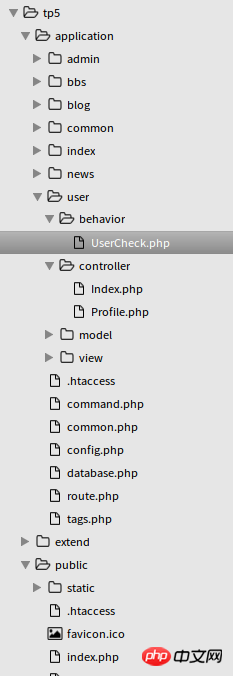Heim >Backend-Entwicklung >PHP-Tutorial >Die Verwendung von Verhaltensweisen in ThinkPHP5
Die Verwendung von Verhaltensweisen in ThinkPHP5
- 不言Original
- 2018-04-04 14:47:541866Durchsuche
本篇文章中的内容是ThinkPHP5中行为的使用 ,现在分享给大家,有需要的朋友可以参考一下这篇文章的内容
目录结构: 
1.在user\behavior目录下建UserCheck.php(名称随便取)
<?phpnamespace app\user\behavior;use think\Controller;/**
*
*/class UserCheck {
use \traits\controller\Jump;//类里面引入jump;类
//绑定到CheckAuth标签,可以用于检测Session以用来判断用户是否登录
public function run(&$params){
return $this->error('请登录!','index/login');
}
}1
2
3
4
5
6
7
8
9
10
11
12
13
14
15
16
17
18
这里run函数中添加自己检测用户权限的逻辑,可以使用session或者别的…
2.在application目录下tags.php(没有就新建一个,名字固定不能改)把行为与某个标签绑定,这里绑定到了“CheckAuth”
<?phpreturn [ 'CheckAuth' => [ 'app\\user\\behavior\\UserCheck',
],
];1
2
3
4
5
6
7
3 . 在控制器里需要监听的地方写下监听标签代码
user\controller\Index.php
<?phpnamespace app\user\controller;use think\Hook;class Index{
public function index(){
//判断用户是否登录
Hook::listen('CheckAuth',$params); //
echo 'index_end';
}
}
转载:http://blog.csdn.net/u012995856相关推荐:
Das obige ist der detaillierte Inhalt vonDie Verwendung von Verhaltensweisen in ThinkPHP5. Für weitere Informationen folgen Sie bitte anderen verwandten Artikeln auf der PHP chinesischen Website!
Stellungnahme:
Der Inhalt dieses Artikels wird freiwillig von Internetnutzern beigesteuert und das Urheberrecht liegt beim ursprünglichen Autor. Diese Website übernimmt keine entsprechende rechtliche Verantwortung. Wenn Sie Inhalte finden, bei denen der Verdacht eines Plagiats oder einer Rechtsverletzung besteht, wenden Sie sich bitte an admin@php.cn
Vorheriger Artikel:PHP-Dateioperation – Daten aus anderen Dateien zu dieser Datei hinzufügenNächster Artikel:PHP-Dateioperation – Daten aus anderen Dateien zu dieser Datei hinzufügen
In Verbindung stehende Artikel
Mehr sehen- So verwenden Sie cURL zum Implementieren von Get- und Post-Anfragen in PHP
- So verwenden Sie cURL zum Implementieren von Get- und Post-Anfragen in PHP
- So verwenden Sie cURL zum Implementieren von Get- und Post-Anfragen in PHP
- So verwenden Sie cURL zum Implementieren von Get- und Post-Anfragen in PHP
- Alle Ausdruckssymbole in regulären Ausdrücken (Zusammenfassung)

